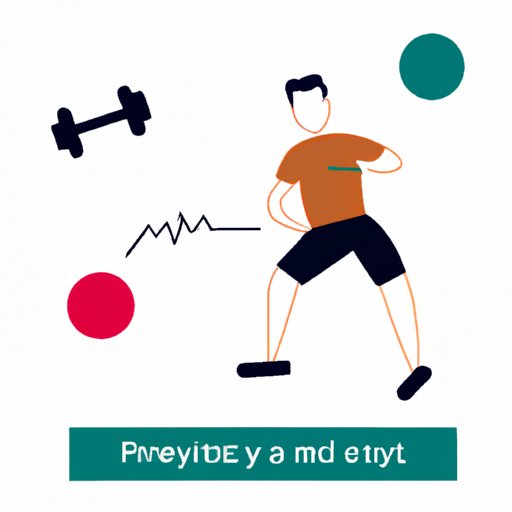
Introduction
It is no secret that physical activity is key to a healthy lifestyle. Adults, regardless of age or fitness level, need to engage in regular exercise to maintain good health and prevent chronic diseases. However, the amount of physical activity necessary can vary for individuals. In this article, we’ll explore the benefits and guidelines of physical activity, as well as provide tips on how to make it a part of your daily routine.
The Benefits of Physical Activity
There’s a reason why doctors recommend engaging in regular physical activity: it offers a myriad of health benefits, including:
- Improved cardiovascular health: Exercise can strengthen the heart, lower blood pressure, and improve circulation.
- Increased muscle strength and endurance: Regular physical activity can improve muscle strength and endurance, making everyday tasks easier to manage.
- Enhanced cognitive function: Regular physical activity can improve cognitive function and reduce the risk of cognitive decline in adults.
- Better mood and mental health: Exercise has numerous emotional benefits, including reducing anxiety and depression and boosting mood.
- Reduced risk of chronic diseases: Engaging in regular physical activity can reduce the risk of chronic diseases, including Type 2 diabetes, heart disease, and obesity.
- Increased longevity: Studies have shown that regular physical activity can increase lifespan and reduce premature mortality.
Guidelines for Physical Activity
Understanding the guidelines for physical activity can be a helpful tool for meeting your exercise goals.
Recommendations from the American Heart Association and other organizations
The American Heart Association recommends adults engage in at least 150 minutes of moderate-intensity aerobic activity per week, or 75 minutes of vigorous-intensity aerobic activity per week. You should aim to spread out your weekly exercise routine across at least three days of the week.
The amount of physical activity needed for different age groups and fitness levels
Age and fitness level can play a role in the amount of physical activity needed. Older adults and those with limited mobility may require lower-impact exercise routines, while younger adults may benefit from more intense workouts.
Different types of physical activity and their benefits
There are three primary types of physical activity: cardio, strength training, and flexibility exercises. All three offer unique benefits, and a well-rounded exercise routine should incorporate all three types. Cardiovascular exercise can improve heart health and endurance, while strength training can increase muscle mass and overall strength. Flexibility exercises, such as yoga or stretching, can improve range of motion and reduce the risk of injury.
Tips for Making Physical Activity a Part of Your Daily Routine
The following tips can help you make physical activity a habit:
Setting realistic goals
Start with reasonable exercise goals and build up from there. Begin with small goals, such as a 10-minute walk each day, and gradually increase the intensity and duration of your workouts.
Creating a workout plan
A workout plan can help you stay focused and on track. Consider setting aside specific times of the day for exercise and plan out your workouts in advance.
Finding a workout buddy
Working out with a friend can make exercise more enjoyable and keep you both accountable. Plus, a little healthy competition can be motivation to push yourself further.
Incorporating physical activity into daily tasks
Small changes to your daily routine can make a big difference. Consider taking the stairs instead of the elevator or parking your car further from your destination to increase your daily physical activity.
A Closer Look at the Health Risks of Sedentary Behavior
Explanation of sedentary behavior
Sedentary behavior refers to prolonged periods of sitting, often for more than 30 minutes at a time.
The health risks associated with a sedentary lifestyle
Physical inactivity is linked to numerous health risks, including obesity, heart disease, type 2 diabetes, and poor circulation. Being sedentary for prolonged periods can also lead to musculoskeletal issues, including back pain and poor posture.
Tips for reducing sedentary behavior
Reducing sedentary behavior can involve simple changes, such as taking breaks from sitting every 30 minutes, standing during phone calls, or taking short walks throughout the day. Consider using a standing desk or incorporating stretching and exercise breaks into your routine.
How to Make Exercise Fun
Importance of finding enjoyable activities
Engaging in physical activity should be enjoyable, rather than a chore. Finding activities that you enjoy can make exercise more appealing and something that you look forward to.
Examples of fun and engaging physical activities
There are numerous physical activities to engage in, from dancing to team sports to hiking. Consider trying new activities to find what works best for you.
Tips for staying motivated
Staying motivated can be challenging, but breaking up your exercise routine and setting milestone goals can help keep you on track. Reward yourself for meeting your goals and consider joining fitness groups or classes, where you can meet new people and gain accountability.
Conclusion
Regular physical activity is essential for good health, and guidelines from organizations such as the American Heart Association can be helpful in reaching exercise goals. Making physical activity a part of your daily routine, reducing sedentary behavior, and finding enjoyment in exercise are key to making it a regular part of your life. Remember, even small changes to your routine can lead to significant improvements in your health and overall wellbeing.




